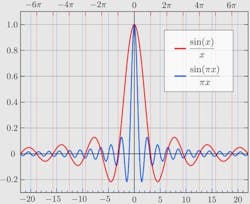High-quality sinc-shaped Nyquist optical pulses could boost fiber-optic data throughput tenfold
| The unnormalized sinc function sin(x)/x is shown in red; the normalized sinc function sin(πx)/(πx) is in blue (same shape, just a different horizontal scale). (From Wikipedia; Author: Georg-Johann) |
Lausanne, Switzerland--While many techniques are being used to boost fiber-optic data throughput, including multicore fiber, superchannels, and multilevel modulation formats, optimally shaping the individual light pulses traveling through the fiber can further increase data density simply by allowing pulses to be closer together without interfering with each other. Researchers at École Polytechnique Fédérale de Lausanne (EPFL) have created extremely high-quality versions of light pulses having the best-possible shape for this -- the sinc function (see figure), resulting in so-called Nyquist sinc pulses.1 These pulses satisfy the Nyquist criterion of zero inter-symbol interference (ISI).
"These pulses have a shape that's more pointed, making it possible to fit them together, a little bit like the pieces of a jigsaw puzzle lock together," says Camille Brès, one of the researchers. "There is of course some interference, but not at the locations where we actually read the data."
To create the pulses, the researchers synthesize a rectangular-shaped (in the spectral domain) phase-locked frequency comb; because the Fourier transform of a rectangle is the sinc function, sinc-shaped pulses (in the time domain) result. The rectangular frequency comb is produced using a single laser and external modulator. The researchers say their all-optical technique can be easily integrated into communications systems.
Source: http://phys.org/news/2013-12-ten-throughput-optic-fibers.html
REFERENCE:
1. Marcelo A. Soto et al., Nature Communications (2013); doi: 10.1038/ncomms3898
